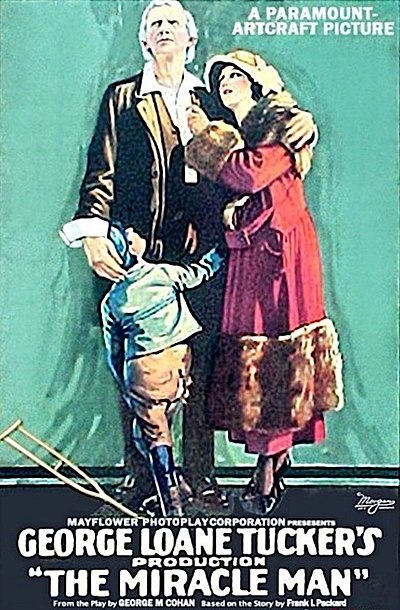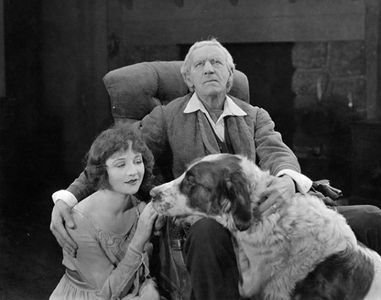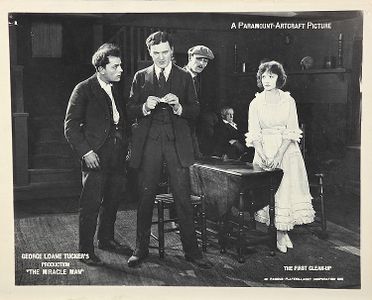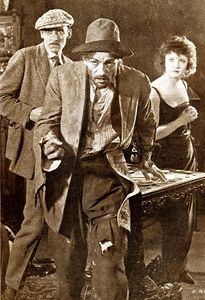The Miracle Man (partially found Lon Chaney drama film; 1919)
The Miracle Man is an American silent drama film, released on August 29th, 1919. The film; directed, produced, and written by George Loane Tucker, and starring Lon Chaney, Thomas Meighan and Betty Compson, was released by Paramount.[1] The film brought instant fame to Lon Chaney and his other co-stars, and was the second highest grossing film of 1919,[2] along with being considered one of the best films of its time by both critics and audience members.[3]
Plot
A gang of four from New York, lead by Tom Burke (Thomas Meighan) develop a plan to exploit a small town just outside of Boston. The rest of the gang consists of Rose (Betty Compson), a con artist who is posing as a street walker; "The Dope" (J.M. Dumont), a drug addict who is pretending to pimp out Rose, and The Frog (Lon Chaney), a man who is a contortionist.
In the small town, is a Patriarch (Joseph Dowling), whom the gang plans to use in a scheme, in which Rose poses as the Patriarch's long lost relative. Frog goes to a town gathering as the Patriarch appears, and Frog begins his scheme, posing as a crippled man. He crawls towards the healer, and straightens his limbs as he approaches the man, appearing to be healed. A crippled boy, upon seeing this, slowly approaches before throwing his crutches down and rushes towards the Patriarch, embracing the man to the shock of the gang.
Burke helps to spread the story across the country, attracting many people in search of being healed by the Patriarch, while the gang collects money. A millionaire named Richard King (W. Lawson Butt) brings his sister to be healed, and after she is cured, gives Burk $50,000. King meets Rose during the visit to town, and the two end up falling for each other.
The gang begins to fall apart due to the work of the healing powers of the Patriarch, with Burke becoming jealous do to Rose sorrow over King's leaving. The Dope also gives up drugs and falls in love, while the Frog gives up crime and begins to take care of a lonely widow. King returns to propose to Rose, but she ends up realizing her heart belongs to Burke, who has now given up his life of crime, and the two begin a new life after the Patriarch dies.[4][5][6]
Availability
The film was successful and well received, and was still being shown as late as 1927.[7] Though with that, and along with the significance of jump starting the career of Lon Chaney, the film is now mostly lost. Two surviving fragments, both from Paramount compilations from the 1930s, still exist, however. The first is from The House That Shadows Built, released in 1931, which celebrates Paramount's 20th anniversary. The second is from "Movie Memories", released in 1935, where the famous healing scene was preserved. It's likely the complete print of the film still existed until at least 1935, and is unknown when it was lost. The film's survival was being questioned as early as 1949,[8] thought it is unknown when the film was first considered "lost".
Only around three minutes of eighty minute film survived.[9] The surviving fragments has been included in several releases, including a Lon Chaney documentary. A reconstruction has been made as well, with a runtime just under half of the original runtime, utilizing surviving stills.[10]
Gallery
Videos
Images
See Also
External Links
- Wikipedia article on The Miracle Man.
- IMDb page for House That Shadows Built.
- IMDb page for Lon Chaney: Behind the Mask.
References
- ↑ Silentera listing of the film. Retrieved 26 Jun '21
- ↑ List of highest grossing films of the silent era, with The Miracle Man towards the end, and the second film mentioned of 1919. Retrieved 26 Jun '21
- ↑ Newspaper clipping of a headline. Retrieved 26 Jun '21
- ↑ AFI Synopsis of the film. Retrieved 26 Jun '21
- ↑ All Movies synopsis of the film. Retrieved 26 Jun '21
- ↑ Newspaper article about the film's plot. Retrieved 26 Jun '21
- ↑ Newspaper clipping from 1927 on the film's success. Retrieved 26 Jun '21
- ↑ Newspaper clipping from 1949 on the film's survival. Retrieval 26 Jun '21
- ↑ Silentera infomation of the film, mentioning the three minutes of surviving content. Retrieved 26 Jun '21
- ↑ The film's reconstruction. Retrieved 26 Jun '21




